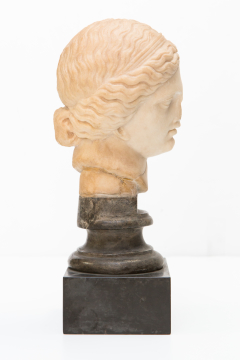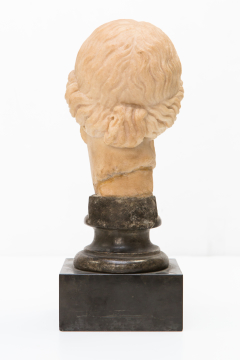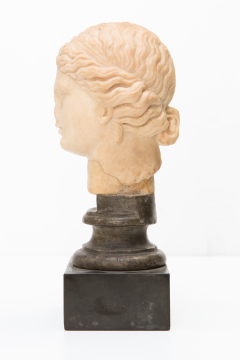Explore Collections


You are here:
CollectionsOnline
/
Head from a Roman statuette of Urania
Browse
Head from a Roman statuette of Urania
Early 2nd century AD
Greek island marble
Height (excluding modern pedestal): 12cm
Length (face): 6cm
Length (face): 6cm
Museum number: A31
On display: Lobby to the Breakfast Room
All spaces are in No. 13 Lincoln's Inn Fields unless identified as in No. 12, Soane's first house.
For tours https://www.soane.org/your-visit
Curatorial note
A not unpleasing, though well polished Roman early Second Century garden copy of the head of a Muse in the stylistic tradition of the sculptor Praxiteles. A similar head, in a larger scale (and, naturally, unretouched), was discovered in the excavations of the 'Aedes Veiovis Inter Arcem et Capitolium' in Rome and is now in the Museo Nuovo Capitolino.1 This Soane head is a replica of a small statue representing the Muse Urania seated fully draped with her right leg crossed over her left and her head supported by her right arm with elbow resting on the right thigh. The work is, as Ashmole states2, known to us from at least six other copies, five of which are discussed by Lippold3 who saw the original as the work of a later Hellenistic sculptor of the so-called 'academic reaction' in the second century BC. The unmistakeable resemblance to the Tyche of Antioch by Eutychides4 shows that the sculptor of the Muse used this work as the general inspiration for the pose of his type. Unlike the other surviving replicas, the copy in Malaga preserves both the original head and the identifying attribute of the globe at the feet.5
1 See A. M. Colini, 'Aedes Veiovis inter Arcem et Capitolium' in Bullettino della Commissione Archeologica Comunale di Roma, Vol. 70 (1942), p. 56.
2 B. Ashmole, A Catalogue of the Ancient Marbles at Ince Blundell Hall, Oxford, 1929, 83c, pl. 22.
3 G. Lippold, Mitteilungen des deutschen archäologischen Instituts, Römische Abteilung, XXXIII, 1918, p. 64ff.
4 Eutychides of Sicyon (c.335-275 BC) was a pupil of the great Greek sculptor Lysippus. His original cult statue of Tyche (the goddess of Fortune: Fortuna to the Romans) is lost but there are a number of fine surviving Roman copies. One of the finest is in the Vatican, inv. 2672. Amongst Soane's collection of antique gems is one, inventory no. DS.112, depicting the Tyche of Antioch.
5 Manuel Gómez-Moreno and José Pijoán, Materiales de Arqueología Espãnola, Madrid, 1912, pl. XX, no. 20, p. 55; Antonio García y Bellido, Esculturas Romanas de España y Portugal, Madrid, 1949, p. 170, no. 186, pl.140.
1 See A. M. Colini, 'Aedes Veiovis inter Arcem et Capitolium' in Bullettino della Commissione Archeologica Comunale di Roma, Vol. 70 (1942), p. 56.
2 B. Ashmole, A Catalogue of the Ancient Marbles at Ince Blundell Hall, Oxford, 1929, 83c, pl. 22.
3 G. Lippold, Mitteilungen des deutschen archäologischen Instituts, Römische Abteilung, XXXIII, 1918, p. 64ff.
4 Eutychides of Sicyon (c.335-275 BC) was a pupil of the great Greek sculptor Lysippus. His original cult statue of Tyche (the goddess of Fortune: Fortuna to the Romans) is lost but there are a number of fine surviving Roman copies. One of the finest is in the Vatican, inv. 2672. Amongst Soane's collection of antique gems is one, inventory no. DS.112, depicting the Tyche of Antioch.
5 Manuel Gómez-Moreno and José Pijoán, Materiales de Arqueología Espãnola, Madrid, 1912, pl. XX, no. 20, p. 55; Antonio García y Bellido, Esculturas Romanas de España y Portugal, Madrid, 1949, p. 170, no. 186, pl.140.
Unrecorded.
Soane collections online is being continually updated. If you wish to find out more or if you have any further information about this object please contact us: worksofart@soane.org.uk









